Encapsulation of Variabilin in Stearic Acid Solid Lipid Nanoparticles Enhances Its Anticancer Activity in Vitro
Abstract
1. Introduction
2. Results and Discussion
2.1. Isolation and Characterization of 7E,12E,20Z- and 7E,12Z,20Z-Variabilin (1 and 2)
2.2. Synthesis and Characterization of Var-SLNs
2.3. Cytotoxic Activity of the Mixture of 1 and 2 and Var-SLNs
2.4. Apoptotic Effects of Variabilin and Var-SLNs
3. Materials and Methods
3.1. General Experimental Procedures
3.2. Sponge Collection and Taxonomy
3.3. Isolation and Characterization of Variabilin (1 and 2)
3.4. Preparation and Characterization of Variabilin Loaded Stearic Acid Solid Lipid Nanoparticles (Var-SLNs)
3.5. Cell Culture and Cytotoxicity Studies
3.6. Apoptosis Assays
3.7. Statistical Analyses
4. Conclusions
Supplementary Materials
Author Contributions
Funding
Acknowledgments
Conflicts of Interest
References
- Siegel, R.L.; Miller, K.D.; Jemal, A. Cancer statistics, 2019. CA Cancer J. Clin. 2019, 69, 7–34. [Google Scholar] [CrossRef]
- Harbeck, N.; Gnant, M. Breast Cancer. Lancet 2017, 389, 1134–1150. [Google Scholar] [CrossRef]
- Vanderpuye, V.; Grover, S.; Hammad, N.; Prabhaker, P.; Simonds, H.; Olopade, F.; Stefan, D.C. An update on the management of breast cancer in Africa. Infect. Agents Cancer 2017, 12, 13. [Google Scholar] [CrossRef] [PubMed]
- Babb, C.; Urban, M.; Keilkowski, D.; Kellet, P. Prostate cancer in South Africa: Pathology based national cancer registry data (1996–2006) and mortality rates (1997–2007). Prostate Cancer 2014, 2014, 319252. [Google Scholar]
- Ferlay, J.; Soerjomataram, I.; Dikshit, R.; Eser, S.; Mathers, C.; Rebelo, M.; Parkin, D.M.; Forman, D.; Bray, F. Cancer incidence and mortality worldwide: Sources, methods and major patterns in GLOBOCAN 2012. Int. J. Cancer 2015, 136, E359–E386. [Google Scholar] [CrossRef]
- Choi, K.; Hong, J.; Lee, C.O.; Kim, D.K.; Sim, C.J.; Im, K.S. Cytotoxic Furanosesterterpenes from a Marine Sponge Psammocinia sp. J. Nat. Prod. 2004, 67, 1186–1189. [Google Scholar] [CrossRef]
- Liu, Y.; Mansoor, T.; Hong, J.; Lee, C.-O.; Sim, C.J.; Im, K.S.; Kim, N.D.; Jung, J.H. New cytotoxic sesterterpenoids and norsesterterpenoids from two sponges of the genus Sarcotragus. J. Nat. Prod. 2003, 66, 1451–1456. [Google Scholar] [CrossRef]
- Rifai, S.; Fassouane, A.; Pinho, P.M.; Kijjoa, A.; Nazareth, N.; Nascimento, M.S.J.; Herz, W. Cytotoxicity and inhibition of lymphocyte proliferation of fasciculatin, a linear furanosesterterpene isolated from Ircinia variabilis collected from the Atlantic coast of Morocco. Mar. Drugs 2005, 3, 15–21. [Google Scholar] [CrossRef]
- Barrow, C.J.; Blunt, J.W.; Munro, M.H.G. Autooxidation studies on marine sesterterpene tetronic acid, variabilin. J. Nat. Prod. 1989, 52, 346–359. [Google Scholar] [CrossRef]
- Muller, R.H.; Mader, K.; Gohla, S. Solid lipid nanoparticles (SLN) for controlled drug delivery—A review of the state of the art. Eur. J. Pharm. Biopharm. 2000, 50, 161–177. [Google Scholar] [CrossRef]
- Watkins, R.; Wu, L.; Zhang, C.; Davis, R.M.; Xu, B. Natural product-based nanomedicine: Recent advances and issues. Int. J. Nanomed. 2015, 10, 6055–6074. [Google Scholar]
- Singh, B.R.; Kaur, I.P. Encapsulation of Rifampicin in a solid lipid nanoparticulate system to limit its degradation and interaction with Isoniazid at acidic pH. Int. J. Pharm. 2013, 446, 106–111. [Google Scholar] [CrossRef] [PubMed]
- Pooja, D.; Kulhari, H.; Kuncha, M.; Rachamalla, S.S.; Adams, D.J.; Bansal, V.; Sistla, R. Improving Efficacy, Oral Bioavailability, and Delivery of Paclitaxel Using Protein-Grafted Solid Lipid Nanoparticles. Mol. Pharm. 2016, 13, 3903–3912. [Google Scholar] [CrossRef] [PubMed]
- Höller, U.; König, G.M.; Wright, A.D. Two New Sesterterpene Tetronic Acids from the Marine Sponge Ircinia oros. J. Nat. Prod. 1997, 60, 832–835. [Google Scholar] [CrossRef]
- Koteswari, P.; Krishna, S.R.; Reddy, V.P.; Nasaru, L.M. Formulation and preparation of felodipine nanoemulsion. Asian J. Pharm. Clin. Res. 2011, 4, 116–117. [Google Scholar]
- Bhatterjee, S. DLS and zeta potential—What they are what they are not? J. Control. Release 2016, 235, 337–351. [Google Scholar] [CrossRef]
- Saraste, A.; Pulkki, K. Morphologic and biochemical hallmarks of apoptosis. Cardiovasc. Res. 2000, 45, 528–537. [Google Scholar] [CrossRef]
- Majno, G.; Joris, I. Apoptosis, oncosis and necrosis: An overview of cell death. Am. J. Pathol. 1995, 146, 3–5. [Google Scholar]
- Su, H.-J.; Tseng, S.-W.; Lu, M.-C.; Liu, L.-L.; Chou, Y.; Sung, P.-J. Cytotoxic C21 and C22 terpenoid-derived metabolites from the sponge Ircinia sp. J. Nat. Prod. 2011, 74, 2005–2009. [Google Scholar] [CrossRef]
- Eskiler, G.G.; Cecener, G.; Dikmen, G.; Egeli, U.; Tunca, B. Solid Lipid Nanoparticles: Reversal of Tamoxifen resistance in breast cancer. Eur. J. Pharm. Sci. 2018, 120, 73–88. [Google Scholar] [CrossRef]
- Mmola, M.; Roes-Hill, M.L.; Durrell, K.; Bolton, J.J.; Sibuyi, N.; Meyer, M.E.; Beukes, D.R.; Antunes, E. Enhcanced Antimicrobila and Anticancer activity of Silver and Gold Nanoparticles synthesized using Sargassum Incisifolium aqueous extracts. Molecules 2016, 21, 1633. [Google Scholar] [CrossRef] [PubMed]
- Sibuyi, N.R.; Thovhogo, N.; Gabuza, K.B.; Meyer, M.D.; Drah, M.; Onani, M.O.; Skepu, A.; Madiehe, A.M.; Meyer, M. Peptide-Functionalized nanoparticles for the selective induction of apoptosis in target cells. Nanomedicine 2017, 12, 1631–1645. [Google Scholar] [CrossRef]
Sample Availability: Samples of the compounds Var-SLNs are available from the authors. |
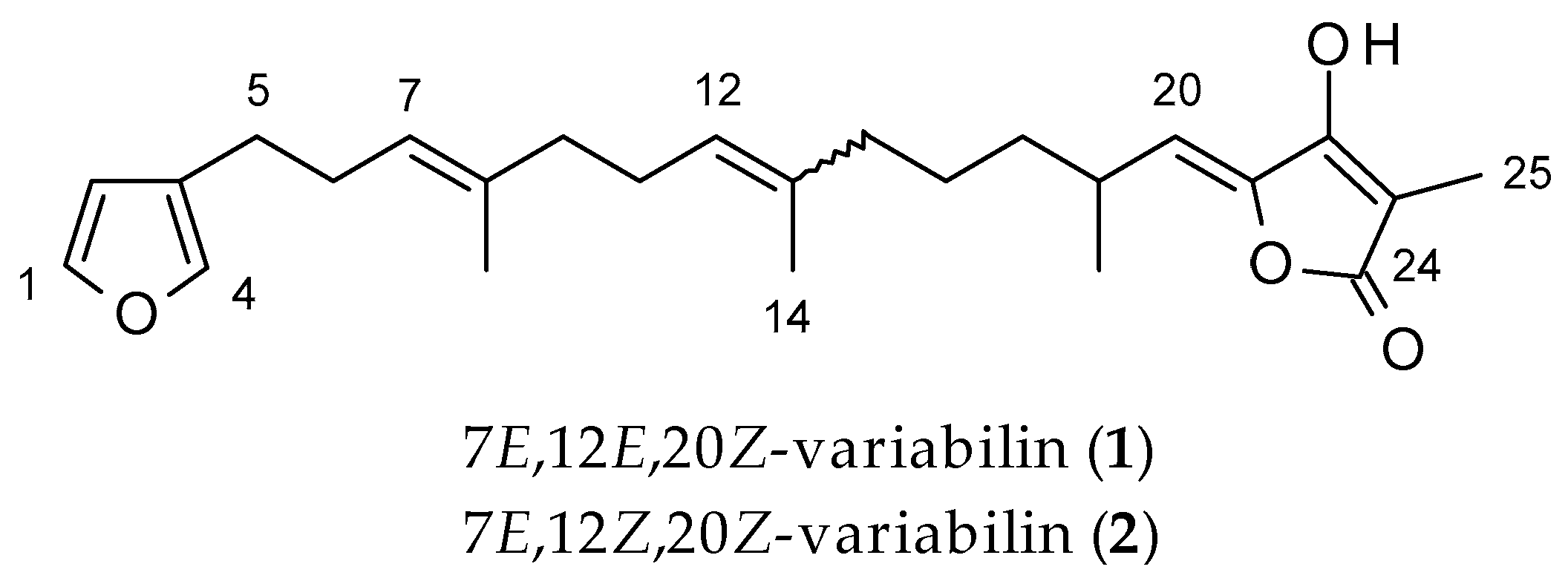
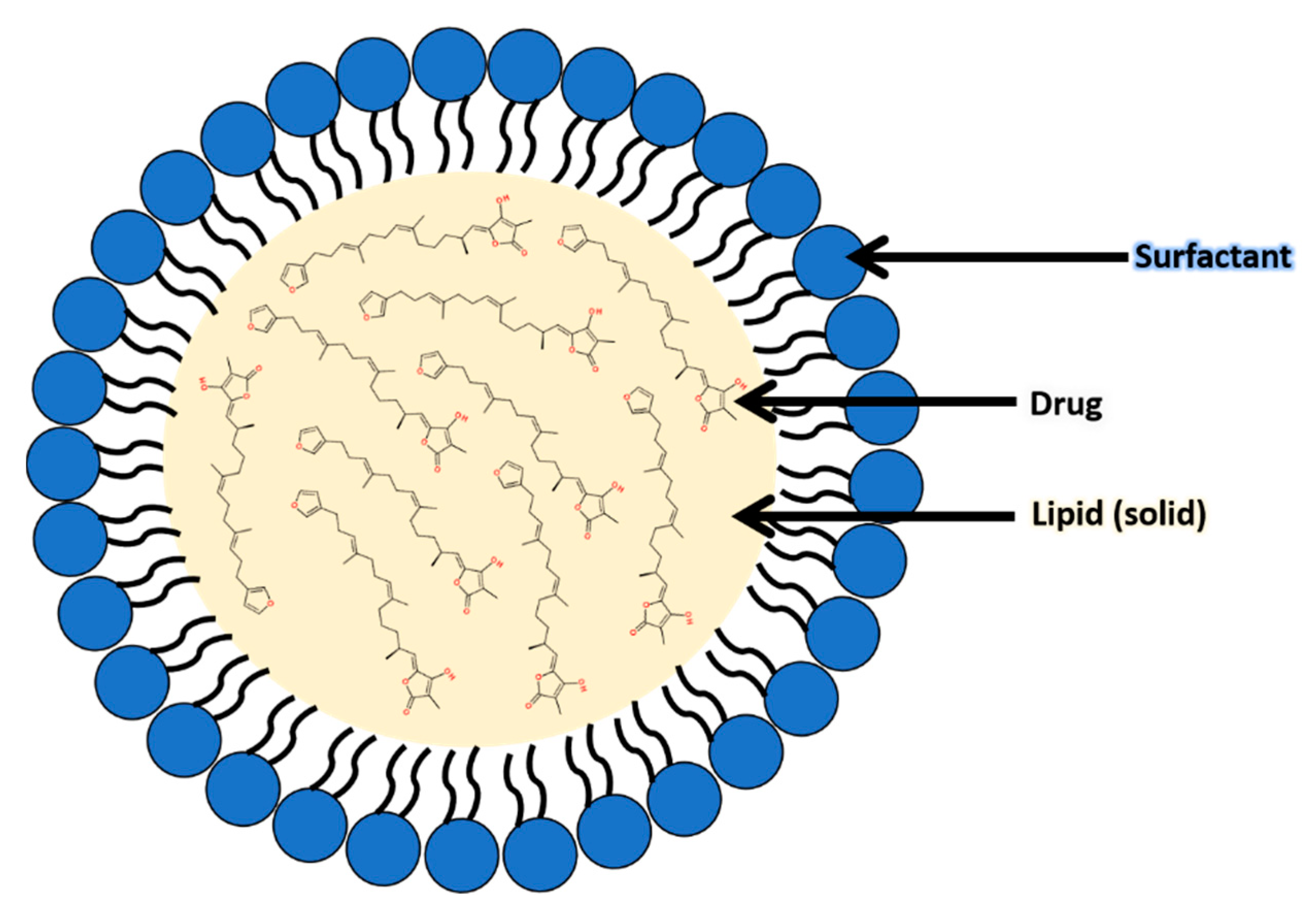
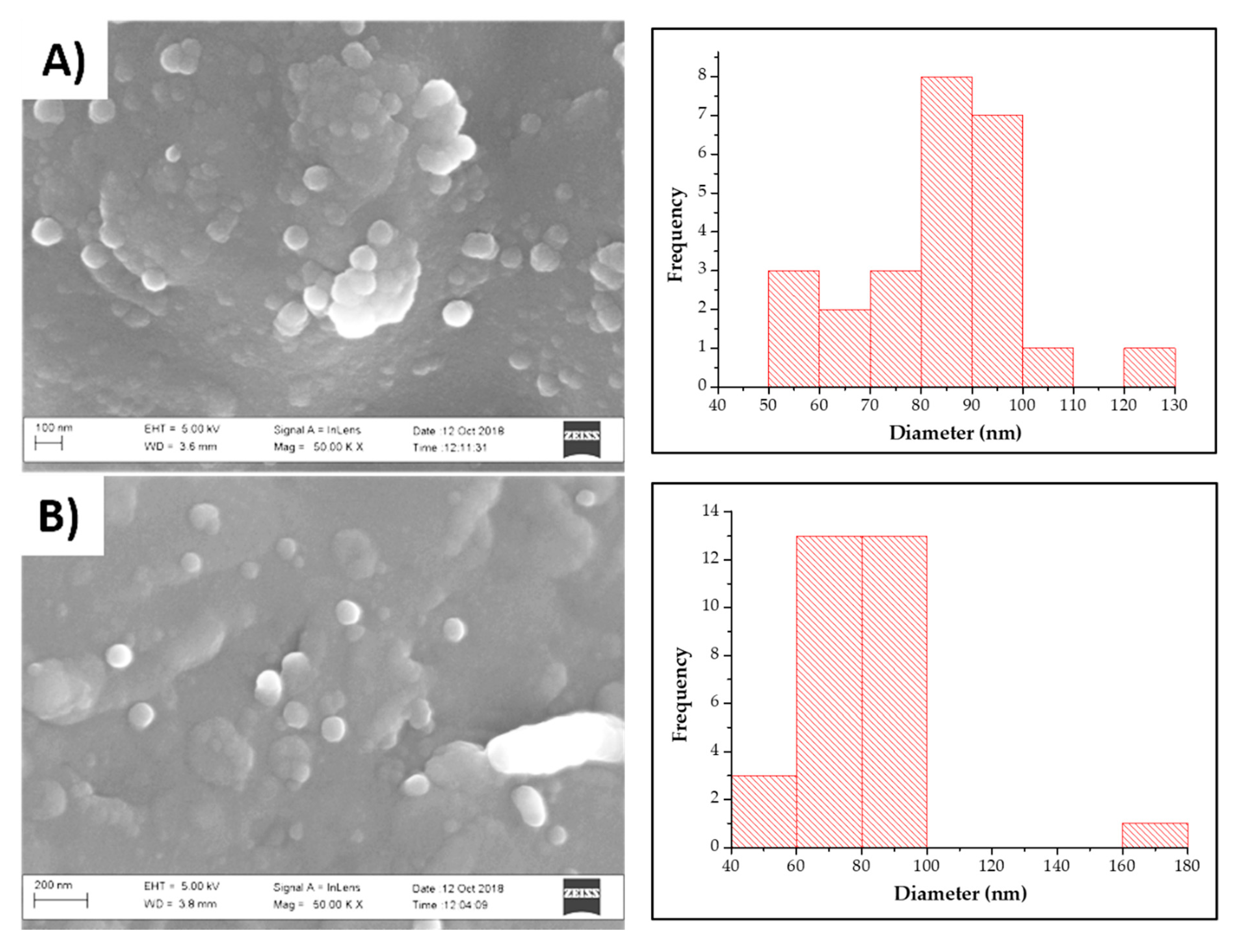
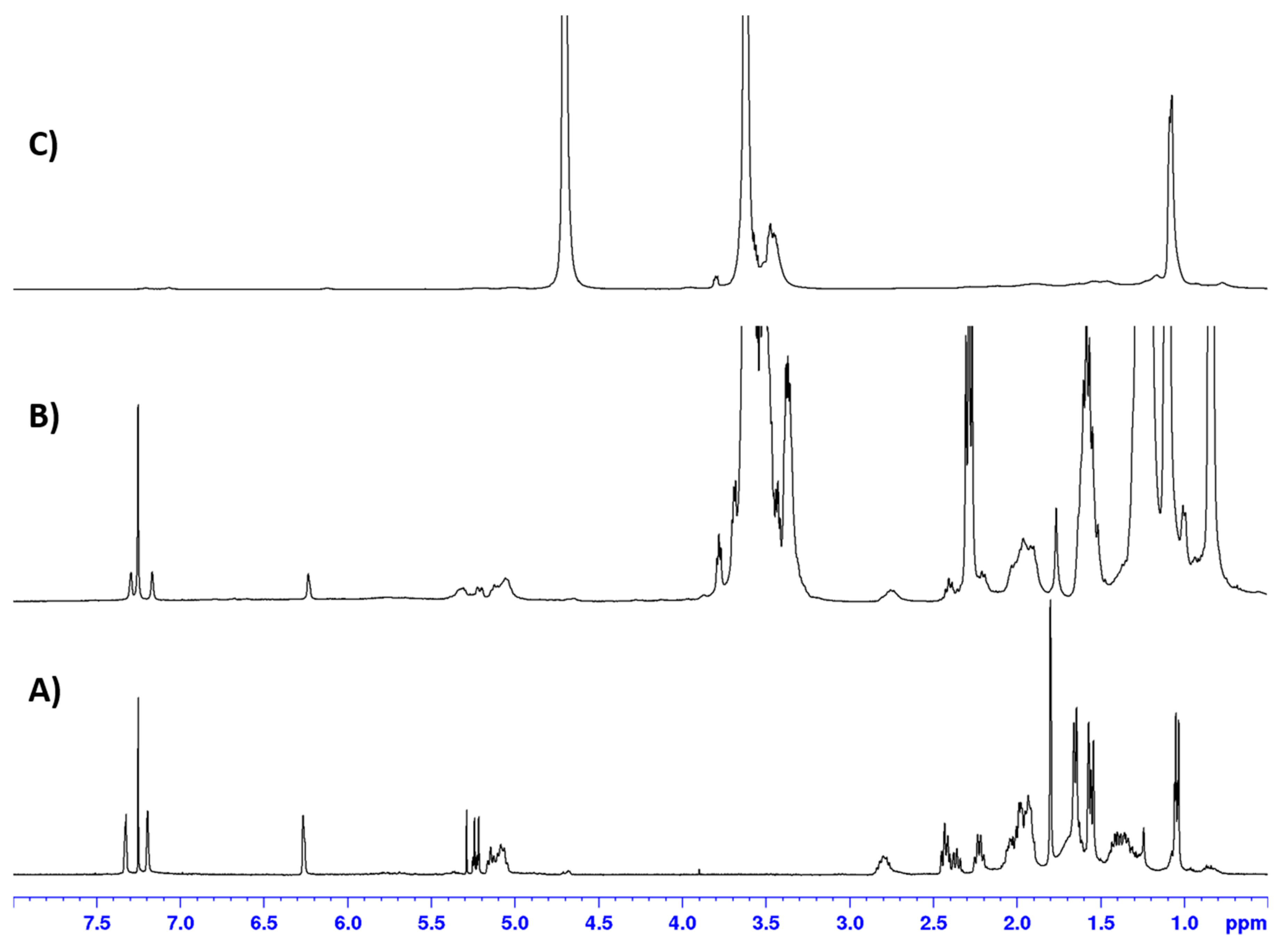
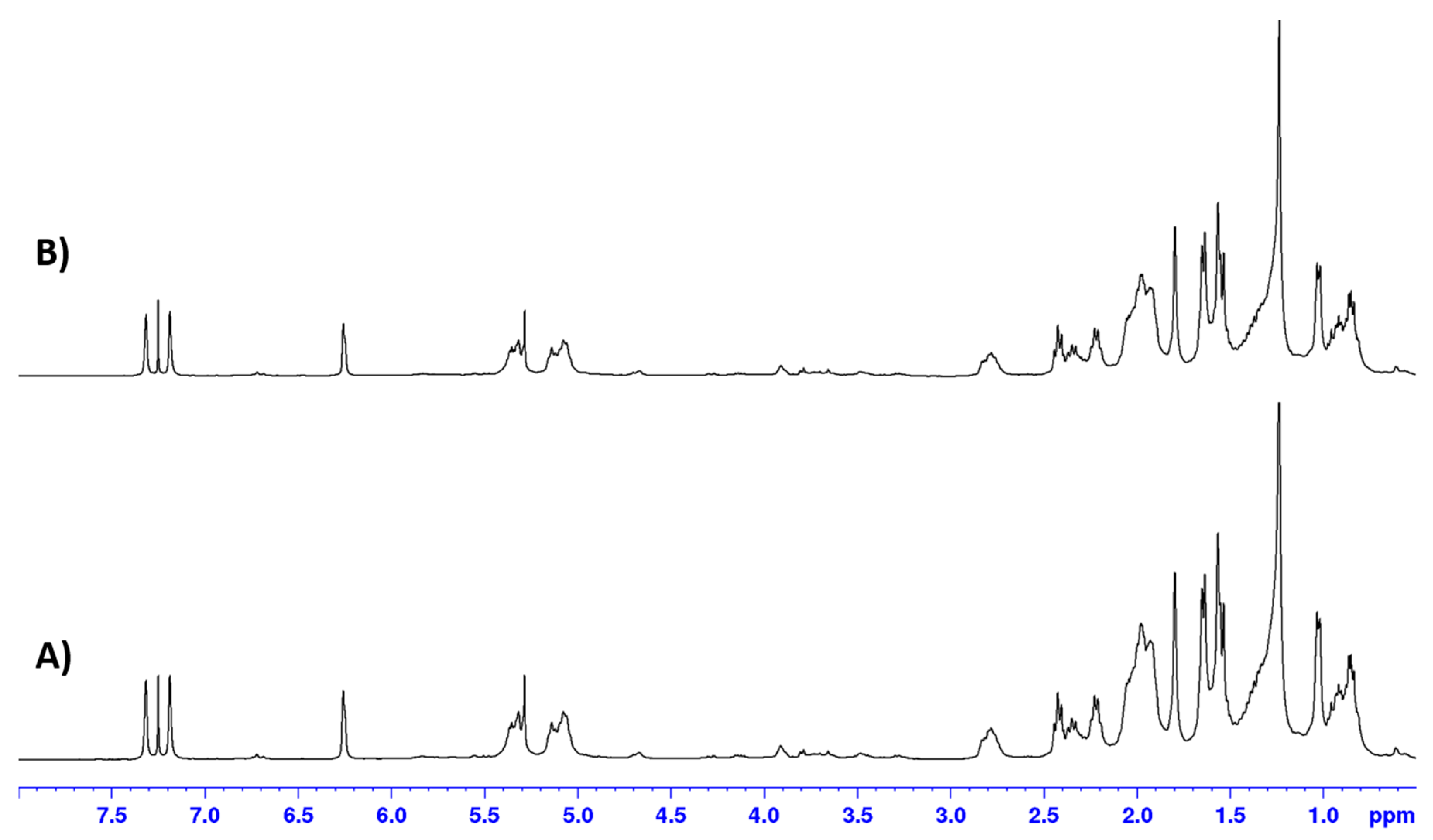
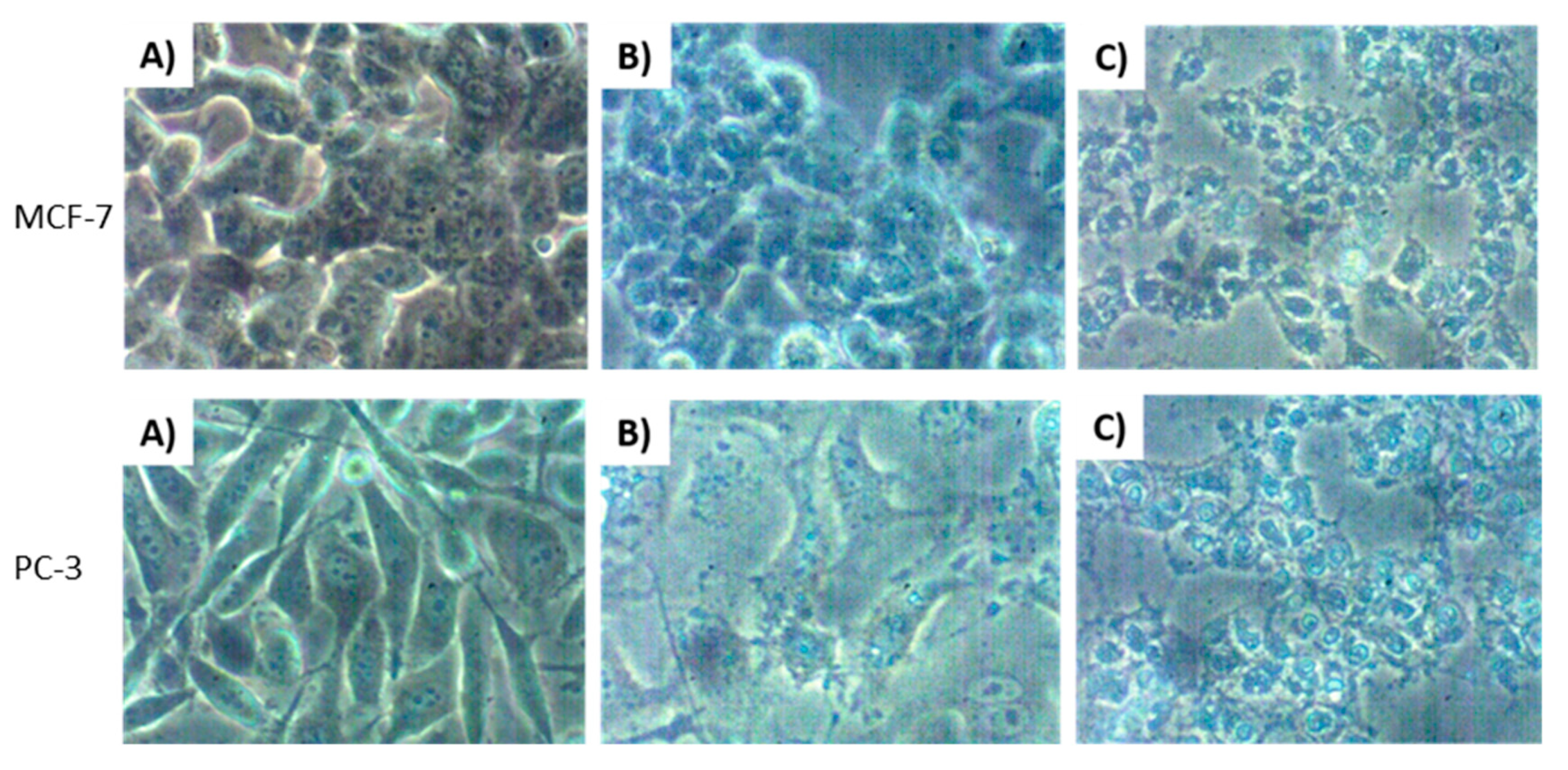

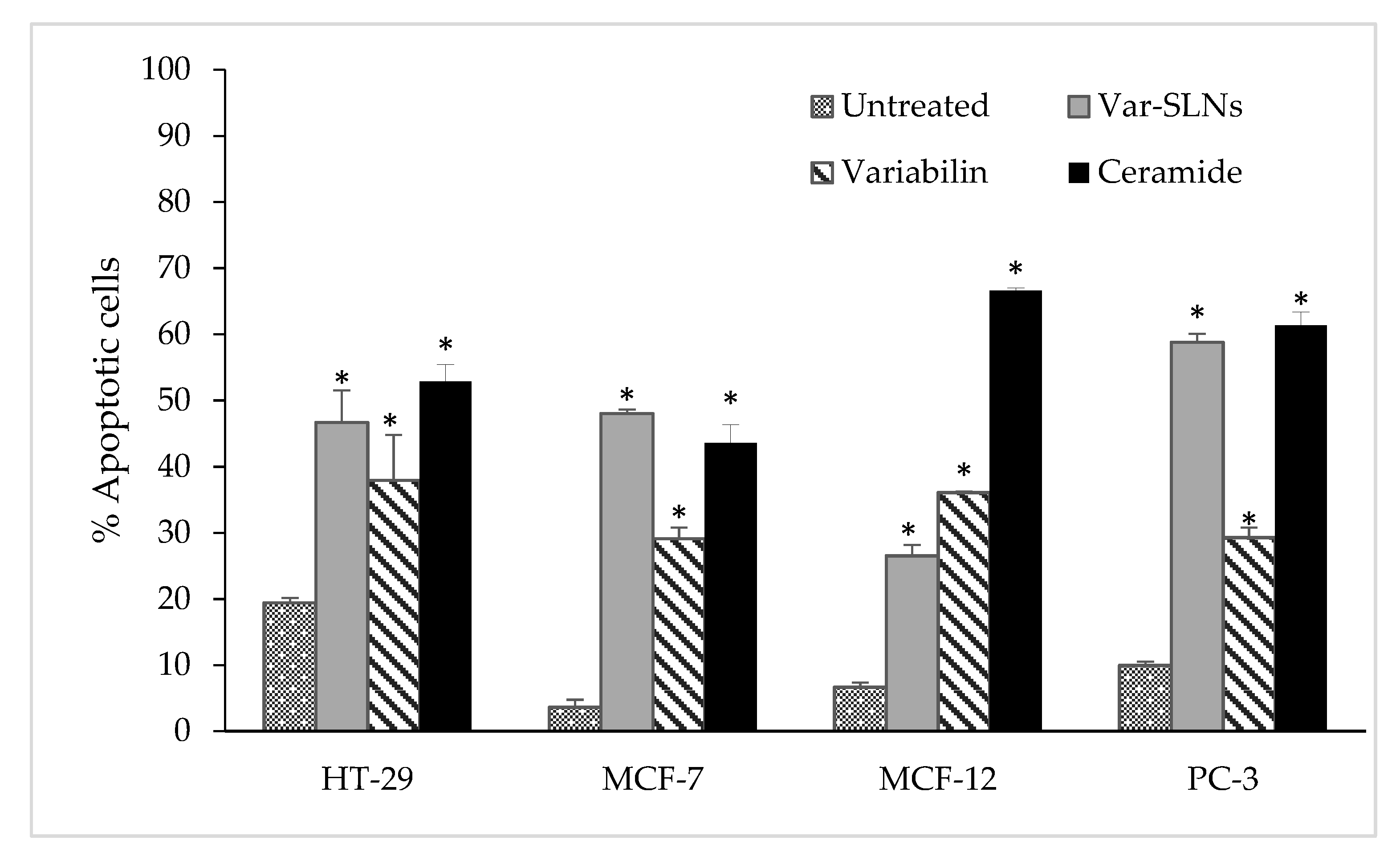
| Hydrodynamic Radii (nm) | PDI | ||||
|---|---|---|---|---|---|
| Sample | t = 0 | t = 14 days | Zeta Potential (mV) | t = 0 | t = 14 days |
| Var-SLNs | 198.2 ± 42.56 | 338.4 ± 57.70 | −31.4 ± 5.16 | 0.129 | 0.136 |
| Blank-SLNs | 322.8 ± 36.02 | 824.1 ± 59.64 | −18.3 ± 4.68 | 0.161 | 0.336 |
| Cell Line | Var-SLN | Variabilin | Ceramide |
|---|---|---|---|
| PC-3 | 8.94 | 87.74 | 4.81 |
| MCF-12 | >100 | >100 | >100 |
| MCF-7 | 34.83 | 38.08 | 33.61 |
| HT-29 | >100 | >100 | >100 |
© 2020 by the authors. Licensee MDPI, Basel, Switzerland. This article is an open access article distributed under the terms and conditions of the Creative Commons Attribution (CC BY) license (http://creativecommons.org/licenses/by/4.0/).
Share and Cite
Lerata, M.S.; D’Souza, S.; Sibuyi, N.R.S.; Dube, A.; Meyer, M.; Samaai, T.; Antunes, E.M.; Beukes, D.R. Encapsulation of Variabilin in Stearic Acid Solid Lipid Nanoparticles Enhances Its Anticancer Activity in Vitro. Molecules 2020, 25, 830. https://doi.org/10.3390/molecules25040830
Lerata MS, D’Souza S, Sibuyi NRS, Dube A, Meyer M, Samaai T, Antunes EM, Beukes DR. Encapsulation of Variabilin in Stearic Acid Solid Lipid Nanoparticles Enhances Its Anticancer Activity in Vitro. Molecules. 2020; 25(4):830. https://doi.org/10.3390/molecules25040830
Chicago/Turabian StyleLerata, Mookho S., Sarah D’Souza, Nicole R.S. Sibuyi, Admire Dube, Mervin Meyer, Toufiek Samaai, Edith M. Antunes, and Denzil R. Beukes. 2020. "Encapsulation of Variabilin in Stearic Acid Solid Lipid Nanoparticles Enhances Its Anticancer Activity in Vitro" Molecules 25, no. 4: 830. https://doi.org/10.3390/molecules25040830
APA StyleLerata, M. S., D’Souza, S., Sibuyi, N. R. S., Dube, A., Meyer, M., Samaai, T., Antunes, E. M., & Beukes, D. R. (2020). Encapsulation of Variabilin in Stearic Acid Solid Lipid Nanoparticles Enhances Its Anticancer Activity in Vitro. Molecules, 25(4), 830. https://doi.org/10.3390/molecules25040830






